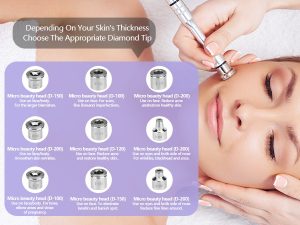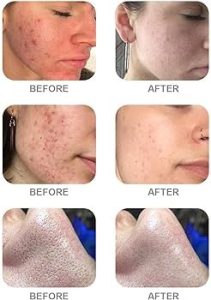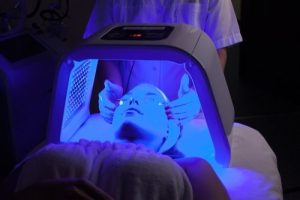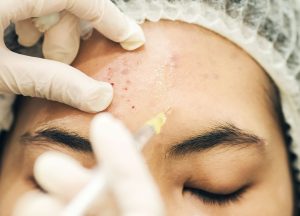Several procedures can help reduce acne and improve the overall appearance of the skin:

Chemical Peels:
- Chemical peels involve applying a chemical solution to the skin, which exfoliates the top layer and promotes cell turnover. This can help unclog pores, reduce inflammation, and treat acne. They work by applying a chemical solution to the skin, which causes the top layer to peel off. The skin takes on a white or ‘frosted’ appearance, which is the result of the acid neutralizing on the skin’s surface. Revealing fresher, smoother skin underneath.
- Salicylic acid is a beta hydroxy acid (BHA) known for its ability to penetrate deep into the pores, effectively exfoliating the skin and removing excess oil and dead skin cells. Salicylic acid peels are typically mild to moderate in strength, making them suitable for various skin types, including sensitive skin.
- Azelaic acid not only unclogs pores but also helps kill acne-causing bacteria on your skin. It can also even out your skin tone by getting rid of free radicals, toxins that can damage your cells.
Microdermabrasion:

Microdermabrasion uses a device to exfoliate the outer layer of the skin, helping to remove dead skin cells and unclog pores. It can also stimulate collagen production and improve the texture of the skin.
Laser Therapy/laser resurfacing:
- Photodynamic therapy: Photodynamic Laser is target the combination of light and heat to target both acne-causing bacteria and the sebaceous glands that produce oil. It can help reduce acne lesions and improve overall skin texture.
- Fractional Laser Therapy: Fractional lasers create tiny wounds in the skin, stimulating collagen production and promoting cell turnover. This helps improve acne scars and can also reduce active acne by targeting the sebaceous glands.
- Er:YAG laser: It can be effective in reducing acne by targeting multiple factors that contribute to its development. The laser works by precisely targeting the upper layers of the skin, promoting exfoliation, reducing sebum production, and killing acne-causing bacteria.
- Nd YAG laser: Short pulse Nd YAG laser an important role in treating acne.

HydraFacial:
It can be beneficial for acne-prone skin as it combines cleansing, exfoliation, extraction, hydration, and antioxidant protection in one treatment. It helps to unclog pores, remove impurities,hydrate the skin, and improve overall skin health. However, the effectiveness of HydraFacial for acne depends on various factors, including the severity and type of acne, individual skin sensitivities, and other concurrent treatments.
Extraction:
Extraction plays a crucial role in the reduction of acne by removing comedones (blackheads and whiteheads), pus-filled pimples, and other debris from the skin by using sterile tools. This helps to unclog pores, reduce inflammation, promote healing and reduce the risk of further breakouts.
Blue Light Therapy:

Blue light therapy targets the bacteria that cause acne specifically Propionibacterium acnes. It can help to reduce inflammation and prevent future breakouts. It’s often used in combination with other acne treatments for best results. The wavelength of blue light used in blue light therapy typically ranges from about 405 to 470 nanometers (nm). This range is effective for treating conditions like acne and certain skin disorders due to its ability to target and kill specific bacteria and reduce inflammation.
Botulinum toxin (BTX):

Botulinum toxin (BTX) injections are primarily used to reduce the appearance of wrinkles by temporarily paralyzing muscles. While BTX injections are not typically used as a direct treatment for acne itself, they can indirectly benefit acne-prone skin by reducing oil production and pore size. It is used diluted form as a Mesotherapy.



